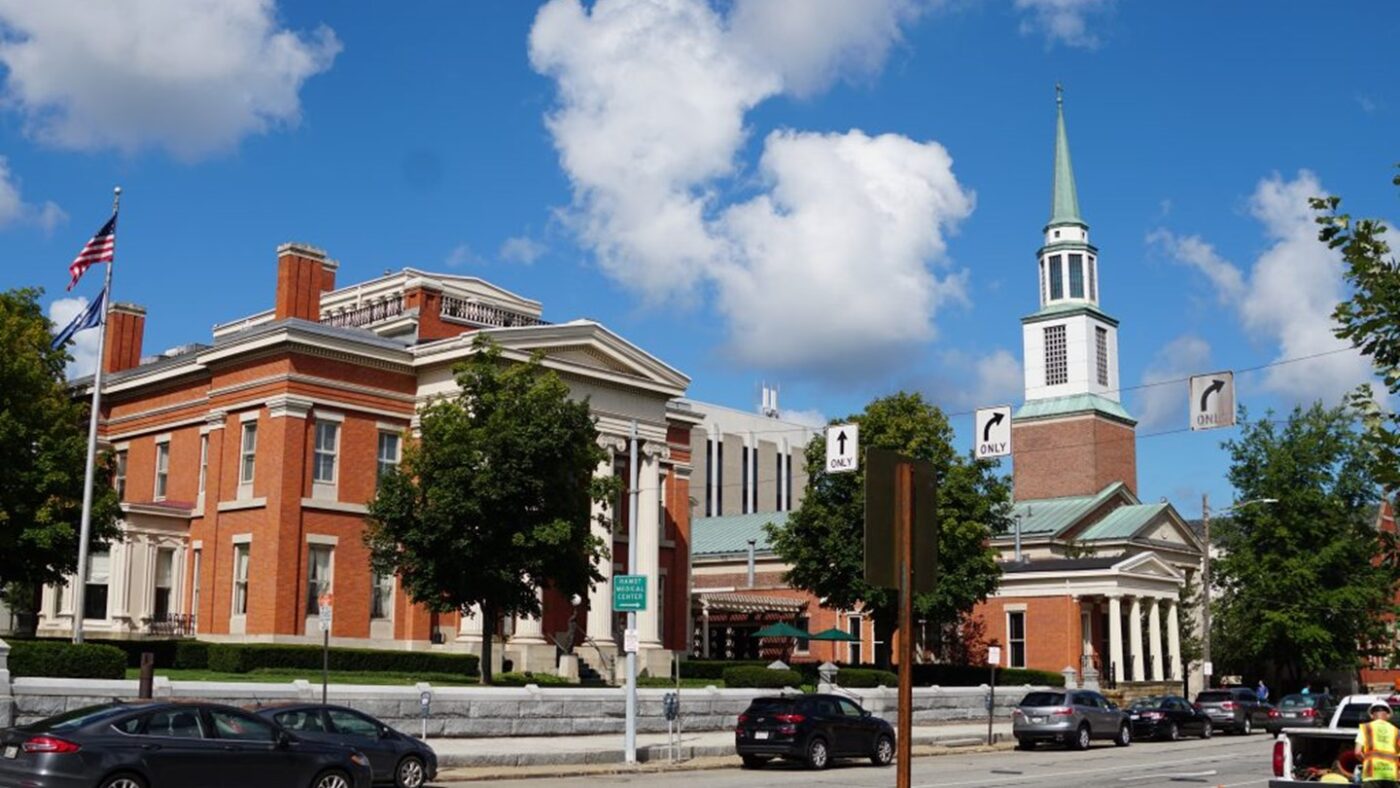Pittsburgh Green Garage Initiative
Free-standing parking garages are often identified as poor energy performers. In 2014, 73% of City of Pittsburgh garages reported energy consumption more than national median average baselines. Modernizing garage lighting enables operators to utilize high efficiency lighting and control systems which can create cost savings, energy consumption reductions and advancements in building performance.

The Solution
In 2014, the Pittsburgh Green Garage Initiative (PGGI) began with GBA and the City of Pittsburgh asking if Pittsburgh’s parking garages could become efficient, renewable, resilient structures through installation of solar photovoltaics with battery backups on upgraded, publicly owned assets. The result was a more formal collaboration to create green, renewable and smart parking garages. Partners included GBA, the City, Public Parking Authority of Pittsburgh (PPAP), Urban Redevelopment Authority of Pittsburgh (URA), and Sports & Exhibition Authority of Pittsburgh & Allegheny County (SEA). The initiative worked collaboratively between agencies to maximize energy efficiency and reduce environmental impacts and encourage sustainable mobility solutions for municipally operated parking facilities in the City of Pittsburgh.
Changes to City of Pittsburgh Lighting Code
In the Spring of 2014, Mayor William Peduto and City Councilman Dan Gilman, with assistance from Green Building Alliance, the Sports and Exhibition Authority (SEA), and the City’s Department of Innovation and Performance-Office of Sustainability, created a simple change to the City of Pittsburgh’s municipal garage lighting code.
This change was necessary due to a discrepancy in the existing code. The SEA and their engineer CJL Engineering discovered the conflicting language while planning a lighting retrofit at three of their garages.
Lighting Code Amendment
An ordinance amending the Pittsburgh City Code, Title Seven Business Licensing, Article VII Service Businesses, Chapter 763 Parking Lots, Section 763.04 Safety Requirements to update lighting requirements for enclosed parking garages to be consistent with the City of Pittsburgh Lighting Code.
(g) On and after January 1, 1985, the lighting in every part of all enclosed parking garages in which attendants do not park all vehicles shall be consistent with the standards set forth in the City of Pittsburgh Lighting Code, Title 12 Lighting Code, Chapter 1201 Lighting Code, Section 1201.07 Required Calculations for Lighting Installations, Table 7 (E) and (F) Recommended Maintained Illuminance and Luminance Values. a minimum of five (5) foot candles at all times, measured at a level of five (5) feet above the ground. The License Officer may grant an extension for compliance to this provision to any parking garage for the minimum period required to complete renovations for any parking garage which began planning renovations prior to July 1, 1984 but could not complete those renovations which include new lighting by January 1, 1985.
Parking Lots – Average Maintained Illuminance Values (Eavg) in Footcandles
| Fields of Measurement | Basic | Special Pedestrian Security |
| Minimum Horizontal Illuminance | 0.2 | 0.5 |
| Uniformity Ratio, Max-to-Min | 20:1 | 15:1 |
| Minimum Vertical Illuminance | 0.1 | 0.25 |
Recommend Maintained Illuminance for Parking Garages
| Minimum Horizontal2 fc | Maximum/Minimum Horizontal Uniformity Ratio3 | Minimum Vertical4 fc | |
| Basic1 | 1.0 | 10:1 | 0.5 |
| Ramps5 | 2.0 | ||
| Day6 | 2.0 | 10:1 | 1.0 |
| Night | 1.0 | 10:1 | 0.5 |
| Entrance Areas7 | |||
| Day6 | 50 | 25 | |
| Night | 1.0 | 10:1 | 0.5 |
| Stairways | 2.0 | 1.0 |
1: For typical conditions. While these values are intended to address personal security issues, some retailers may increase them to further offset perceived concerns. Research has shown that, under certain conditions of limited contrast (such as concrete wheel stops on a concrete garage floor), this level is needed to provide good visibility of the wheel stop.
2: Measured on a parking surface, without any shadowing effect from parked vehicles or columns. For preliminary design, and average value of 50 horizontal lux (5 hfc) for basic illuminance (and equivalent for other conditions) may be calculated.
3: The highest horizontal illuminance area, divide by the lowest horizontal illuminance point or area, should not be greater than the ratio shown.
4: Measured at 1.5 meters (5.0 ft.) above parking surface at the point of lowest horizontal illuminance, excluding facing outward along boundaries.
5: Applies to clearway ramps (no adjacent parking) but not to sloping floor designs.
6: Daylight may be considered in the design calculation
7: A high illumanance level for about the first 20 meters (66 ft.) inside the structure is needed to affect a transition from bright daylight to a lower internal level.
The Case for Greener Parking Garages
A collaboration years in the making, PGGI’s roots began in 2013 when SEA was planning to upgrade lighting in three parking garages. The agency was interested in using very high efficiency lighting but realized that there was a discrepancy in the building code that would prevent it from maximizing its efforts. With a unanimous vote to resolve the code change, just one year after completing its resulting retrofits, SEA experienced 64% reductions in annual electricity use. The payback period for the retrofit of 1,356 fixtures with accompanying motion and daylighting sensors is 3.5 years. Duquesne Light rebates helped SEA recoup 18% of its cost.
“ This is a great example of interagency cooperation and innovation – and Pittsburgh’s leadership in energy efficiency and building performance. It is a smart investment in our infrastructure that will save energy, reduce operational costs, and provide for a better customer experience. ”
William Peduto, Mayor of Pittsburgh
The Pennsylvania Economic Development Association (PEDA) Grant
In 2014, the City of Pittsburgh, with cooperation from GBA, requested PEDA support the Pittsburgh Green Garage Initiative through grant funding that provided seed capital establishing a Lighting Infrastructure Fund and leveraged both municipal and private parking operator capital investments in lighting upgrades and controls. PEDA awarded funding of nearly $470,000, which enabled the Pittsburgh Parking Authority and the Urban Redevelopment Authority to capitalize significant lighting infrastructure upgrades.
As part of the garage initiative and energy grant, URA retrofitted five local parking structures. For the first nine months of post-retrofit operations, the Authority averaged a 57% reduction in electricity use. URA’s complete retrofit portfolio included five parking garages with 3,051 total parking spaces lit by 1,436 new fixtures. As a result of these impacts, the Authority continued to evaluate its entire parking garage portfolio, and reported plans to leverage savings from its initial projects by reinvesting into other facilities via a new sustainability revolving fund.
Pittsburgh Parking Authority completed a similar First Avenue Garage lighting and controls retrofit in August 2016. CJL Engineering did the lighting design on all complete SEA, URA, and PPAP parking garages and reported plans to design similar retrofits on nine additional garages.
18 public parking garage projects engaged with PGGI indicated that structures of all types have opportunities to reduce their resource use in ways that may often be overlooked or underestimated. As PGGI partners continue to make energy improvements to more structures, PGGI and GBA are ensuring that efficiency opportunities for parking garages – and other oft-overlooked spaces – are brought into the light.
